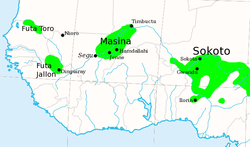Imamate of Futa Jallon
This article includes a list of general references, but it lacks sufficient corresponding inline citations. (February 2013) |
Imamate of Futa Djallon | |||||||||||
|---|---|---|---|---|---|---|---|---|---|---|---|
| 1725–1912 | |||||||||||
|
Left: pre-1896; Right: 1896-1912 Flag | |||||||||||
 The Fulani Jihad States of West Africa, c. 1830. | |||||||||||
| Status | Protectorate of France (1896-1912) | ||||||||||
| Capital | Timbo | ||||||||||
| Common languages | Pular language | ||||||||||
| Religion | Sunni Islam | ||||||||||
| Government | Theocracy | ||||||||||
| Almamy | |||||||||||
• 1725–1777 | Alfa Ibrahim | ||||||||||
• 1906–1912 | Boubacar IV (last) | ||||||||||
| History | |||||||||||
• Established | 1725 | ||||||||||
• French protectorate | November 18th 1896 | ||||||||||
• Disestablished | 1912 | ||||||||||
| |||||||||||
The Imamate of Futa Jallon or Jalon (French: Fouta Djallon; Pular: Fuuta Jaloo or Fuuta Jalon[1]) was a West African theocratic state based in the Fouta Djallon highlands of modern Guinea. The state was founded around 1727 by a Fulani jihad and became part of the French Third Republic's colonial empire in 1896.
Origin
The Fouta Djallon region was settled by the semi-nomadic Fulɓe over successive generations between the 13th and 16th centuries. Initially, they followed a traditional African religion.[citation needed] In the 16th century an influx of Muslim Fulɓe from Macina, Mali changed the fabric of Fula society.
As in the Imamate of Futa Toro, the Muslim and traditionalist Fula of Futa Jallon lived side-by-side. Then, according to traditional accounts, a 17th-century holy war erupted. In 1725, the Muslim Fulɓe took complete control of Futa Jallon after the battle of Talansan and set up the first of many Fula theocratic states to come. Karamokho Alfa was appointed Emir al-Mu'minin ("Commander of the Faithful") and first Almami of the Imamate of Futa Jalon. He died in 1751 and was succeeded by Emir Ibrahim Sori, who consolidated the power of the Islamic state. Futa Jallon's theocratic model would later inspire the Fula state of Futa Toro.
Organization
The new Imamate of Futa Jallon was governed under a strict interpretation of Sharia with a central ruler in the city of Timbo, near present-day Mamou. The Imamate contained nine provinces called diwe, which all held a certain amount of autonomy. These diwe were: Timbo, Timbi, Labè, Koîn, Kolladhè, Fugumba, Kèbaly, Fodé Hadji and Murya,Massi. The meeting of the rulers of these diwè at Timbi decided to introduce Alpha Ibrahima from Timbo as first Almamy Fuuta Jallonke with residence at Timbo. Timbo then became the capital of Fuuta Jallon until the arrival of French colonialists. The objective of the constitution of this Imamate was to convince local communities to become Muslim. It became a regional power through war and negotiation, wielding influence and generating wealth. As a sovereign state, it dealt with France and other European powers as a diplomatic peer while championing artistic and literary achievement in Islamic learning at centers such as the holy city of Fugumba.
The Muslims of Futa Jallon became divided into factions. The clerical faction took the name of the Alfaya out of respect to the legacy of Karamokho Alfa, while the secular faction called themselves the Soriya after his successor Ibrahima Sori.
The two factions came to an agreement that power should alternate between leaders of the two factions.[2] The rulers of the two cities of Timbo and Fugumba were descended from the same original family, and later all competition for the position of almami was between these two cities.[3]
Dominance

The Imamate of Futa Jallon became a multiethnic, multilingual society,[citation needed] ruled by Muslim Fulɓe and backed by powerful free and slave armies. The Fulɓe of Futa Jallon and Futa Toro were able to take advantage of the growing Atlantic slave trade with the Europeans on the coast, particularly the French and Portuguese. The twin Fula states also supplied valuable grain, cattle and other goods to their European neighbors on the coast. The Almaami would demand gifts in return for trade rights and could enforce his will with a well-supplied army. In 1865, Futa Jallon supported an invasion of the Mandinka kingdom of Kaabu, resulting in its demise at the Battle of Kansala in 1867. It conquered the remnants of the Kingdom of Jolof in central Senegambia in 1875.
Decline
The French were not satisfied with mere dominance of the coast and increasingly one-sided trade with the Fulbe. They began making inroads into Futa Jallon by capitalizing on its internal struggles. Finally, in 1896, at the Battle of Porédaka, the French defeated the last Almaami of Futa Jallon, Bokar Biro.
See also
References
Notes
Citations
- ^ Office for Subject Cataloging Policy 1992, p. 1775.
- ^ Sanneh 1997, p. 73.
- ^ Gray 1975, p. 208.
Sources
- Barry, Boubacar (1997-12-13). Senegambia and the Atlantic Slave Trade. Cambridge University Press. p. 98. ISBN 978-0-521-59760-9. Retrieved 2013-02-10.
{{cite book}}: Invalid|ref=harv(help) - Derman, William; Derman, Louise (1973). Serfs Peasants Socialst. University of California Press. ISBN 978-0-520-01728-3. Retrieved 2013-02-10.
{{cite book}}: Invalid|ref=harv(help) - Gray, Richard (1975-09-18). The Cambridge History of Africa. Cambridge University Press. ISBN 978-0-521-20413-2. Retrieved 2013-02-10.
{{cite book}}: Invalid|ref=harv(help) - Office for Subject Cataloging Policy (1992). Library of Congress subject headings. Cataloging Distribution Service, Library of Congress. Retrieved 16 February 2013.
{{cite book}}:|author=has generic name (help); Invalid|ref=harv(help) - Sanneh, Lamin O. (1997). The Crown and the Turban: Muslims and West African Pluralism. Basic Books. ISBN 978-0-8133-3058-7. Retrieved 2013-02-10.
{{cite book}}: Invalid|ref=harv(help)
External links


